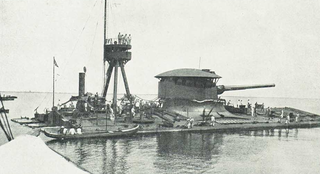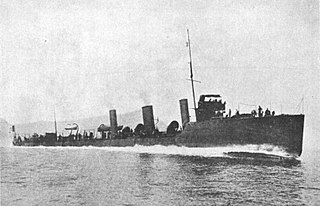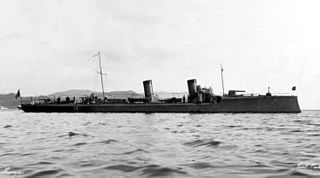 W
WAlfredo Cappellini was an Italian monitor converted from the floating crane GA53 during World War I. She bombarded Austro-Hungarian positions during the Eleventh Battle of the Isonzo in 1917 before she was wrecked off Ancona on 16 November 1917.
 W
WThe Italian destroyer Audace was originally ordered by Japan from Yarrow Shipbuilders in Scotland under the name of Kawakaze, but was transferred to Italy in 1916 while still under construction. She served as the command ship for the radio-controlled target ship San Marco in 1937–1940 and then was rearmed for convoy escort and patrolling duties when World War II began. Audace was captured by the Germans in 1943 and used by them as a minelayer and escort ship in the Adriatic Sea until she was sunk by a pair of British destroyers in late 1944.
 W
WCarabinere was a Soldato-class destroyer of the Italian Regia Marina The ship was laid down on 7 November 1905 at the Ansaldo shipyard in Genoa. She was launched on 12 October 1909 and completed on 26 January 1910. She was reclassified as a torpedo boat on 1 July 1921 and discarded on 7 May 1925.
 W
WThe Italian Castore-class gunboats, Castore and Polluce, were a class of two Rendel gunboats, designed and built by Sir W G Armstrong Mitchell & Co.'s Elswick Works in the late 1880s to a contract by the Italian War Ministry. Designed by Philip Watts and Herbert Rowell, and constructed in Elswick's Tyneside yard in the United Kingdom, the two gunboats were disassembled and shipped to Italy for reassembly in the Armstrong facility at Pozzuoli, proving to be the only ships constructed there after the Italian government cancelled the shipyard project. It is uncertain whether the vessels were designed as testbeds for heavy guns, or were intended from the outset as operational gunboats.
 W
WEuropa was a seaplane carrier of the Italian Regia Marina. Originally laid down as the merchant ship Manila, she was renamed Salacia in 1898, and then sold to German and then Italian shipping companies in 1911 and 1913, respectively. She became Quarto in 1913, and in February 1915 she was purchased by the Italian fleet, renamed Europa, and converted into a seaplane carrier with a capacity of eight seaplanes. She served as a seaplane base in Valona during World War I and supported the Allied response during the Battle of the Strait of Otranto in 1917. She was quickly sold for scrap in 1920 after the war ended.
 W
WFaà di Bruno was an Italian monitor built during World War I. Completed in 1917, the ship played a small role in the 11th Battle of the Isonzo later that year. She was decommissioned in 1924, but returned to service as the floating battery GM 194 at the beginning of World War II and was towed to Genoa and where she spent the rest of the war. The ship had her guns disabled when the Royal Navy bombarded Genoa in 1941. GM 194 was captured by the Germans after the Italian Armistice in 1943 and was turned over to the puppet Repubblica Sociale Italiana that they installed afterward. She was scuttled at the end of the war and subsequently scrapped.
 W
WThe Indomito class was a class of destroyers of the Italian Royal Navy before and during World War I. Six were built at Naples by Societa Pattison between 1910 and 1913. They were the first large Italian destroyers and the first fitted with steam turbines. The class is sometimes also called the I class. Two of the class were sunk during World War I, but the four surviving ships remained in service until 1937–38. One of the class, Insidioso, was reinstated during World War II and served in the Règia Marina and the German Kriegsmarine before being sunk by U.S. aircraft in late 1944.
 W
WThe Lampo class was a class of six destroyers of the Italian Regia Marina built by the German Schichau shipyard from 1899–1901. They served in the Italo-Turkish War and the surviving ships in the First World War, before being disposed of between 1920 and 1924.
 W
WItalian hospital ship Marechiaro was a steam ship originally built by an Italian shipping company, but requisitioned for use as an Italian hospital ship during the First World War. On February 21, 1916 she was sunk near the Albanian port of Durrës by a mine laid by the German U-boat UC-12. British drifters Hasting Castle and Selina saved 104 men from the water while 33 were killed. Other sources mention over 200 casualties.
 W
WThe Mirabello class were a group of three destroyers built for the Regia Marina during World War I. Carlo Alberto Racchia was sunk by a mine in the Black Sea during the Allied intervention in the Russian Civil War in 1920. The remaining two ships, obsolescent by 1938, were re-rated as destroyers and participated in World War II. Carlo Mirabello was also lost to a mine while escorting a convoy in 1941. The last surviving ship, Augusto Riboty, was reconfigured as a convoy escort in 1942–1943. The torpedo tubes were removed and depth charges and 20 mm (0.79 in) anti-aircraft guns added. She survived the war and was transferred to the Soviet Union as war reparations in 1946. The ship was scrapped five years later.
 W
WThe Nembo class was a class of destroyer of the Italian Regia Marina. Six destroyers were built by the Pattison shipyard of Naples between 1899 and 1905, to a design based on the contemporary destroyers of the British shipyard Thornycroft. They were active in the Italo-Turkish War and in the First World War, where three were lost.
 W
WThe SS Principessa Mafalda was an Italian transatlantic ocean liner built for the Navigazione Generale Italiana (NGI) company. Named after Princess Mafalda of Savoy, second daughter of King Victor Emmanuel III, the ship was completed and entered NGI's South American service between Genoa and Buenos Aires in 1909. Her sister ship SS Principessa Jolanda (1907) had sunk immediately upon launching on 22 September 1907.
 W
WThe Soldato class was a class of destroyers of the Italian Regia Marina built by Ansaldo of Genoa prior to the First World War. Ten were built for the Regia Marina between 1905 and 1910, while an eleventh ship was built for China but purchased by Italy before completion. They served during the First World War, where one was lost, with the remaining ships sold for scrap in the 1920s and early 1930s.